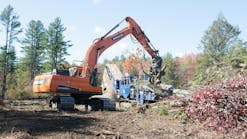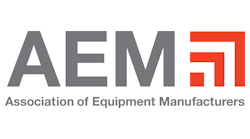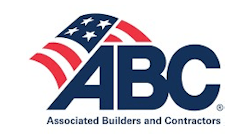Large construction companies with fleets of on-road and off-road vehicles running into the tens of thousands have long known the importance of the computer in managing these critical assets. As Ken Skidgmore, maintenance systems manager for LaFarge Construction Materials, puts it, “Today’s fleet managers need real-time information to keep up in this ever-changing environment. Even small adjustments in equipment purchases, parts management, and regular maintenance can result in dollars saved when based on factual information.”LaFarge has quite a large fleet, approximately 30,000 equipment units and, similar to most large construction firms, has committed to using a fleet management system that he describes as a “product valuable beyond its estimations.” Some large firms, such as AMECO, have developed their own enterprise software for fleet management, but most use one of the fleet management software packages on the market, running them on PCs or midrange computers, such as IBM’s AS/400.Now smaller construction companies are seeing the advantages–even the necessity in their competitive marketplace–of computerizing at least their fleet maintenance operations using one of the quite-capable software packages on the market. TMT Software of Durham, NC (which supplied the system LaFarge uses), revealed what these software systems can accomplish when it described its Transman SQL PRO Base System’s components: repair-order system, preventative maintenance (PM) scheduling, inventory management system, purchase-order system, attached barcode devices, basic warranty analysis/identification, fuel inventory and management, accounting export, and TMT report viewer.While this describes one specific product, it also more or less describes the design philosophy behind most of the fleet management software packages we examined. And virtually every one of these packages has users who are very happy with their investment–and investment is the term they use. Not only do these systems save fleet managers significant time and effort in their jobs, but they have been shown to save surprisingly substantial costs as well. For example, Desmond Hannon, fleet manager of the B.F. Joy Company near Washington, DC, reports that the system he uses (Arsenault’s Dossier package) enabled him to reduce the spare parts inventory for his 300-vehicle fleet from $350,000 to $37,000.Varying System ScopesAlthough the design philosophies of the competing software systems appear to be quite similar, the specifics of each can vary widely. One of the most significant differences is the scope of the system. Since construction is still a relatively small, emerging market for fleet management systems, many of the software firms have adapted the systems they developed for the larger and more mature transportation market. This approach has produced systems that economically provide the construction fleet manager with the functions and features he needs for his business by integrating them into a system that can also solve the problems of a transportation fleet manager. The capability for construction fleet management is included, but the architecture has drawbacks, particularly for smaller contractors.For example, the LB Corporation of Lee, MA, has a small, 46-vehicle fleet that specializes in excavation and concrete forming. Notes LB’s Tracy Garrity, “We’re not a big hauling company that trucks commodities from here to California and back, so we don’t need a complicated system for our operations. It would be overwhelming to learn and operate. Our needs were for a system that’s simple to understand and use but that provides the information we need quickly and efficiently. We found what we wanted in a new fleet maintenance software system on the market–Compufleet from Solutions Construction of Tampa, Florida.“It’s very efficient at tracking the fuel usage and fuel taxes in the two states where we operate. It keeps track of registrations and vehicle sticker renewals; things like that have always been a time-consuming pain to do with a paper system. We don’t ask it to do a lot of things. Why, we don’t even use the PM part of the program. We do all of our major vehicle maintenance and repair in the wintertime–January, February, and March–when there isn’t much excavation because of the snow on the ground. For the other nine months, we rely on driver assessments. If one of them complains about spongy brakes, for example, we check that vehicle’s repair history on the system and determine what to do about it and when. The system does everything we ask of it, quickly and without complications.”Buck Donovan, vice president of Solutions Construction Inc., is quick to point out that his Compufleet system has the capability of doing much more than LB Corporation asks of it. “We have a background in construction, so when we started in the fleet management system business, we initially designed a system for small contractors. Subsequently, we have branched out and added functions that are useful in other markets. We took care to keep our system simple to operate; yet now, in addition to what LB Corp uses it for, it records equipment maintenance, provides PM schedules with checklists, tracks operating costs, monitors parts inventory with auto-reorder, flags warranty items, produces customized reports, creates estimates and invoices, plus much more. What’s more, it’s flexible and scalable; now it can be used by any size of fleet.”“All customers of our Fleet Cost & Care software get the same system,” states Jim Marl of Crane Cost & Care Company in Detroit, MI. “Then we customize it for each individual user by simply ‘turning off’ the functions and features that the user doesn’t want or need. We initially developed the Crane Cost & Care system, so it just made sense to extend it modularly to meet the requirements of users with other specialties.“The construction industry is component-intensive, with a lot more hydraulics, cylinders, tracks, and the like. Our software is geared to handle those components too. Each user can define his own fleet configuration and his own activities, such as PM schedules for each vehicle and each component, if he likes. Thus, contractors can assign parts and action items to a master maintenance and repair facility that is uniquely designed for each machine in their fleet. When they open a work order and insert a maintenance or repair activity, they can print out an action-item checklist of everything that needs to be done on that specific vehicle or equipment, as well as a list of the parts and tasks needed.”What’s more, Marl adds, users can define these activities in whatever terminology they are accustomed to using–whether they are from the Deep South or in Brooklyn, NY. This sort of “user system design” also is offered by Solutions Construction. “Contractors are free to set up their own PM schedules, for instance,” Donovan points out. “And we encourage them to suggest ideas that will enhance the system’s value.”TMT Software also lets each user define his own construction specifics at the outset. Alternatively, he can outsource the definition loading to TMT. “We give them a one- to two-day services session at no cost,” says TMT Vice President Mark Ashdown, “and in the process we show them how to do that definition loading. Usually they’ll learn the process quickly and see that they can do it on their own without any outsourcing expense. And the knowledge they gain allows them to change their system configuration in the future.”As part of the startup, TMT also converts old user data, trains the user staff, and establishes a complete manual customized to that user’s standard operating procedures. Thus, it is not just a generic manual; it documents standardized user-specific procedures for use across the entire company, including at remote job sites. And when the user acquires another company, this documentation is very useful in training the newly added staff.In the course of researching this article, we found that contractors are customizing fleet management software packages to their own needs, often ignoring functions and features that the package offers. For example, Mike Jones of Mitchell Asphalt in Baltimore, MD, freely picks and chooses Arsenault software functions and adapts them to his own needs. He doesn’t use the meter and fuel report to track fuel costs in real time, but he does use it to get mileage and other data to his accounting department for budget allocation.
“I also take the mechanic productivity report and export it to an Excel file,” he adds. “Then I format it into a special report that I use to determine what the guys in the shop get paid. Also, there are special situations that arise where the system can really help. I remember when one of our tractor-trailers was involved in an accident. People always jump to the conclusion that these big vehicles are at fault because of sloppy maintenance. Well, we knew we had one of the better maintenance programs in our area; the problem was how to prove it. “Rather than have to do a lengthy paper search, I simply accessed the Arsenault system and pulled up a really impressive report on the maintenance that had been done to that tractor-trailer. It showed the schedule and amount of time and money that had been spent for brakes, lights, body, everything. The police were completely satisfied and, although I won’t go so far as to say it precluded a lawsuit, I was very glad we had that documentation.”Jim Christey of Blossom Valley Construction in San Jose, CA, says he has one overriding use for his Computerized Fleet Analysis CFAWin system: just-in-time PM. “We have a very high vehicle utilization,” he explains. “We use every one of our 275 vehicles virtually every day. Therefore we don’t bother to track our equipment utilization with the computer. Our concern is keeping our fleet up and running so every vehicle is available every day with an absolute minimum of downtime for maintenance or repairs. “The system generates weekly PM reports for us and schedules the PM we do here or have done for us in the field. With that schedule, we can be assured that all vehicles get their PM on time, yet vehicles don’t stack up here waiting for service on any given day. We do use the CFAWin parts inventory function, but we use it strictly to support our PM program by ensuring that we don’t run out of needed parts when a vehicle is in for PM. The system has helped us tremendously in keeping our equipment up and operating at peak utilization.”Capturing the DataA basic challenge to the efficient use of any fleet management system is capturing the field or shop data electronically so that they don’t have to be rekeyed into the computer. This is particularly important for construction firms that have multiple and often-remote job sites.Toronto, ON—based Cetaris has made an impressive stride toward this goal by implementing wireless technology with its Fleet Assistant system. According to Jim Iglesias, Cetaris offers an optional wireless repair order system featuring a Symbol PDA (personal digital assistant) device (hardened for field conditions) and a wireless network. With it, a mechanic at a job site can log on to the computer at company headquarters, select a repair order, and scan in the vehicle ID. He can then capture labor and parts usage (using the PDA’s built-in integrated barcode scanner to facilitate the quick and accurate entry of part numbers) and other information.“This provides a mobile capability previously unknown in fleet maintenance systems,” Iglesias notes. “Previously a contractor with multiple sites might require a staff of a dozen people to create work orders and fax them to the appropriate job sites. Then the mechanic would write down on the fax what he had done and send it back to headquarters, where the repair data would be manually entered into the system.“Now that company will only need perhaps two employees to create the work orders. If the company equips each job site with a $300 wireless hub and one or more PDA devices, the exchange of data will be seamless and virtually error-free. Not only will this system save labor costs both in the field and at headquarters, but the data captured will be free of data-entry error, can be sent instantaneously, and will eliminate costly and error-prone rekeying.”This system option is already being used in Canada and, at the time of this writing, is being rolled out in the United States. This gives Cetaris a jump on the rest of the industry. TMT Software, for example, is still in development of a PDA-based option comparable to that of Cetaris. TMT hopes to announce it at its conference in October 2002.However, TMT has a unique fleet management system feature of its own–touch-screen technology. With TMT’s touch-screen module, a shop mechanic can complete every task on a displayed work order and in the process create an electronic parts list and an electronic time card for every activity (including idle time). “This makes possible a 100% paperless shop,” Ashdown points out. “And the data captured don’t have to be rekeyed at the home office. That labor savings alone is significant, and it goes right to the bottom line.”Getting Data to the Accounting SystemSince fleet management systems generate so much useful cost data, contractors would like to export these data to their accounting systems, again so that they will not have to rekey them. There are at least three general ways fleet management software suppliers address this issue:They don’t normally do it.They develop interfaces for various accounting software packages.They develop a general-purpose output file.Computerized Fleet Analysis in Addison, IL, does not feature accounting system links, although President Mike Ohlinger says, “We can do it. Our software is open-database [ODB]-compatible so we can transfer data to and from other systems in a file format that some accounting systems can accept. As I said, we can do it, but there’s not much call for it.”Fleet Cost & Care develops interfaces to accounting systems. The firm, which is also an ACCPAC International Inc. accounting system reseller, prides itself on being flexible, so it also has developed interfaces with leading Windows-based accounting software packages. “We can now interface with any Windows-based accounting system that is ODB-compliant,” says Jim Marl. “We use ODB architecture to interface directly with databases. Therefore any data added or changed in our fleet management system update the accounting system database.”Apparently this custom interface approach works well–at least Mick Bryant of the AEI Mining Resources Division thinks so. “From our standpoint, one of the best features of this system is that it can transport data to our Dynamic accounting system so we don’t have to manually enter the same data twice.”TMT takes a general-purpose approach to interfacing with accounting systems. “Our Transman system captures a lot of cost data that accounting people want,” Ashdown points out. “So we have a routine that puts these data in an ASCII file. That way it can be directly accessed by any accounting software system–from a $49 package to a full-blown Oracle system.”Application Service ProvidersMany contractors simply do not want to take on the expense and trouble of buying and maintaining a full fleet management computer system. “We’re construction people,” they reason, and they do not want to divert their focus from their primary operations. Now they can have their way. With the almost universal availability of the Internet, fleet management software suppliers are now also offering to serve contractors and other users as application service providers (ASPs). For a monthly fee, an ASP will maintain a contractor’s fleet management software at its center on sort of a service-bureau basis. Although the contractor’s system resides on the ASP computer, he has complete access to it via the Internet.One of the many fleet management software suppliers offering an ASP service is Arsenault Associates in Atco, NJ. Arsenault simply took its popular Dossier fleet management software and adapted an online version that it calls 24/7 Fleet Online. “Our 24/7 system can be run from just about any computer with Internet access,” states Charlie Arsenault. “A Web browser and a dial-up account through AOL or any of the free ISPs [Internet service providers] is all that’s required.“Effectively using our Dossier software over the Internet means substantially less setup time and provides access and control of the fleet from virtually anywhere for less than $6 a day on a month-to-month, no-obligation basis. A contractor’s fleet maintenance manager doesn’t have to be a data-processing expert. And he can be up and running with the system in a matter of days, scheduling PM; tracking maintenance costs, histories, and warranties; automating parts inventory; keeping an eye on vendors; and saving money throughout.”The use of ASP services is increasing steadily, but not every contractor will want to use this service. Buying your fleet maintenance program and running it in-house on your computer system is the traditional method of acquiring and operating software. Some companies require this method, as it provides the control and security they demand. Even if it is not company policy, there certainly are advantages to owning and operating your own computer system that might outweigh the convenience of an ASP arrangement. Arsenault, who continues to market Dossier as a package, agrees and lists eight persuasive arguments in favor of a contractor owning and operating his own system:Total control of all aspects of software deployment and its operation to satisfy your information technology (IT) department standards.Operating your fleet software on your own computers and communication system provides a level of known security.A one-time purchase eliminates the ongoing invoicing of a rental service.Annual support and upgrades can be purchased on an as-needed or as-wanted basis.Your IT department maintains control of all technology systems and purchases.Corporate assets are increased with the value of the depreciable asset of software.Ancillary services, such as program training, can be purchased on an as-needed basis.Integration of technology and data can be performed as required if the database dictionary is acquired. Obviously the choice depends on each contractor’s particular circumstances. Whichever choice a contractor makes, however, it is likely that the system will pay for itself in many different ways. Arsenault cites instances in which users had maintenance cost savings of up to 30% over three years, 80% of all repair work became scheduled as opposed to emergency, and the warranty dollars increased by 50%.“You can’t predict where all the savings is going to come from,” Donovan says. “Why, if a contractor is changing the oil of just 10 vehicles once too often in a given year, the system can save him almost $1,000 just by keeping to a proper PM schedule. And I recall an instance where a mechanic accidentally changed all the hydraulic oil in a large excavator, an unnecessary loss of $500 that a system-generated PM checklist could have prevented.”Desmond Hannon agrees, citing not just the parts inventory feature that enabled him to cut his parts inventory value by 90% but also the repair-trend feature of his system. “The system showed us that we were getting a lot of flat tires on vehicles at a lot of different job sites,” he recalls. “We investigated and found that most of the flats were occurring at our new-housing-development job sites where there were a lot of nails lying around. As subcontractors, we couldn’t control the job-site conditions, but we could protect the tires with internal tire sealants. As a result, my tire budget dropped by $20,000 and our uptime increased dramatically. I would never have thought that an office system could have such an impact on our field operations.”








